Related Research Articles

William James "Count" Basie was an American jazz pianist, organist, bandleader, and composer. In 1935, he formed the Count Basie Orchestra, and in 1936 took them to Chicago for a long engagement and their first recording. He led the group for almost 50 years, creating innovations like the use of two "split" tenor saxophones, emphasizing the rhythm section, riffing with a big band, using arrangers to broaden their sound, and others. Many musicians came to prominence under his direction, including the tenor saxophonists Lester Young and Herschel Evans, the guitarist Freddie Green, trumpeters Buck Clayton and Harry "Sweets" Edison, plunger trombonist Al Grey, and singers Jimmy Rushing, Helen Humes, Thelma Carpenter, and Joe Williams.

OKeh Records is an American record label founded by the Otto Heinemann Phonograph Corporation, a phonograph supplier established in 1916, which branched out into phonograph records in 1918. The name was spelled "OkeH" from the initials of Otto K. E. Heinemann but later changed to "OKeh". Since 1965, OKeh was a subsidiary of Epic Records, a subsidiary of Sony Music. Today, OKeh is a jazz imprint, distributed by Sony Masterworks.
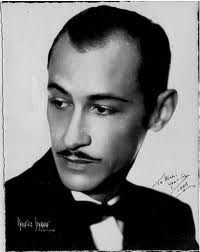
Orie Frank Trumbauer was an American jazz saxophonist of the 1920s and 1930s. His main instrument was the C melody saxophone, a now-uncommon instrument between an alto and tenor saxophone in size and pitch. He also played alto saxophone, bassoon, clarinet and several other instruments.
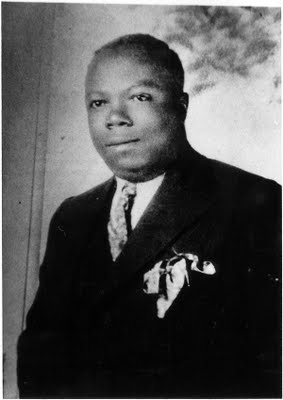
Benjamin Moten was an American jazz pianist and band leader born and raised in Kansas City, Missouri, United States.
Walter Sylvester Page was an American jazz multi-instrumentalist and bandleader, best known for his groundbreaking work as a double bass player with Walter Page's Blue Devils and the Count Basie Orchestra.

Kansas City jazz is a style of jazz that developed in Kansas City, Missouri during the 1920s and 1930s, which marked the transition from the structured big band style to the much more improvisational style of bebop. The hard-swinging, bluesy transition style is bracketed by Count Basie, who in 1929 signed with Bennie Moten's Kansas City Orchestra, and Kansas City native Charlie Parker, who ushered in the bebop style in America.
"Kansas City Shuffle" is the name of a 1926 jazz song.

Julia Lee was an American blues and dirty blues musician. Her most commercially successful number was the US Billboard R&B chart topping hit "(Opportunity Knocks But Once) Snatch and Grab It" in 1947. She is best known for her trademark double entendre songs.

Herschel "Tex" Evans was an American tenor saxophonist who was a member of the Count Basie Orchestra. He also worked with Lionel Hampton and Buck Clayton. He is also known for starting his cousin Joe McQueen's interest in the saxophone. Joe McQueen, living until 2019 at age 100, may well have been the last surviving person to have known Herschel during his lifetime.
Edward Durham was an American jazz guitarist, trombonist, composer, and arranger. He was one of the pioneers of the electric guitar in jazz. The orchestras of Bennie Moten, Jimmie Lunceford, Count Basie, and Glenn Miller took great benefit from his composing and arranging skill.
George Ewing Lee was an American jazz bandleader.
Lottie Kimbrough was an American country blues singer, who was also billed as Lottie Beaman, Lottie Kimborough, and Lena Kimbrough.
Ronald "Jack" Washington was an American jazz saxophonist who was a member of the Count Basie orchestra in the 1930s and 1940s.

The Smithsonian Collection of Classic Jazz is a six-LP box set released in 1973 by the Smithsonian Institution. Compiled by jazz critic, scholar, and historian Martin Williams, the album included tracks from over a dozen record labels spanning several decades and genres of American jazz, from ragtime and big band to post-bop and free jazz.
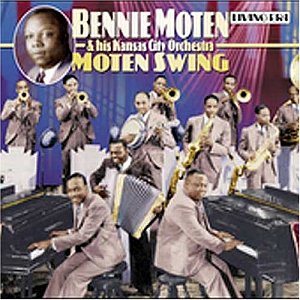
"Moten Swing" is a 1932 jazz standard by Bennie Moten and his Kansas City Orchestra. It was an important jazz standard in the move towards a freer form of orchestral jazz and the development of Swing music. Moten and his Orchestra, which included Count Basie on piano, achieved much success with it, although the song is most associated with Basie's Count Basie Orchestra, who recorded it in 1940.
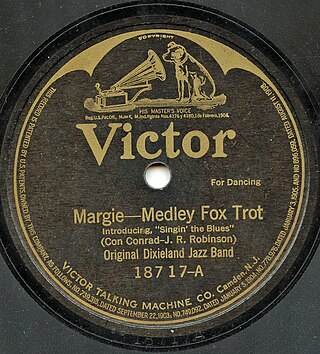
"Singin' the Blues" is a 1920 jazz composition by J. Russel Robinson, Con Conrad, Sam M. Lewis, and Joe Young. It was recorded by the Original Dixieland Jass Band in 1920 as an instrumental and released as a Victor 78 as part of a medley with "Margie". The song was released with lyrics by vocalist Aileen Stanley in 1920 on Victor. In 1927, Frank Trumbauer, Bix Beiderbecke, and Eddie Lang recorded and released the song as an Okeh 78. The Trumbauer recording is considered a jazz and pop standard, greatly contributing to Frank Trumbauer and Bix Beiderbecke's reputation and influence. It is not related to the 1956 pop song "Singing the Blues" first recorded and released by Marty Robbins in 1956.
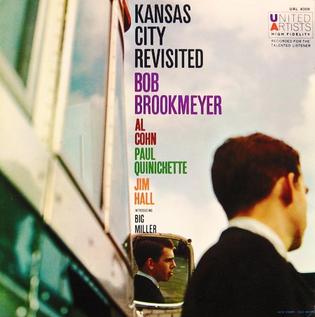
Kansas City Revisited is an album by jazz trombonist and arranger Bob Brookmeyer featuring Brookmeyer's new orchestrations of 1920s and '30s era Kansas City jazz tunes. The album was recorded in 1958 for the United Artists label.
The Chocolate Dandies was the name of several American jazz combos from 1928 through the 1940s. The name was an outgrowth of the Broadway production, The Chocolate Dandies, that debuted in 1924.
Jasper "Jap" Allen was an American jazz musician and bandleader. He played tuba, sousaphone and bass violin.

Mary H. Bradford was an American blues singer, songwriter, composer, and lyricist. She is known for her time performing and recording with Bennie Moten, Ada Brown, and Bennie Moten's Kansas City Orchestra. Bradford was a contra-alto vocalist with a very brief career in music. The first album on which she was featured was with Bennie Moten's Kansas City Orchestra in 1923. Her second and last album was recorded under the name Auntie Mary Bradford in 1928 and was a solo album.
References
- 1 2 3 4 5 6 7 8 9 10 11 12 13 Driggs, Frank; Haddix, Chuck (2005). Kansas City Jazz: From Ragtime to Bebop-A History. Oxford University Press. pp. 41, 53, 55, 93. ISBN 978-0-19-536435-4.
- 1 2 3 4 5 6 7 8 Discography of American Historical Recordings. "Banks, Paul". University of California, Santa Barbara (UCSB) Library. Retrieved 10 December 2022.
- 1 2 3 4 5 Russell, Ross (1971). Jazz Style in Kansas City and the Southwest. Univ of California Press. pp. x, 116. ISBN 0-520-01853-2.
- 1 2 The Jazz Review, Volume 1, Number 1—Volume 2, Number 11, p. 17. 1958. Google Books. Retrieved 10 December 2022.